
As Learjet 75 production winds down, Bombardier’s Wichita site is evolving to become a Center of Excellence for special-mission aircraft, transforming sleek business jets into medevac, head of state, VIP, surveillance and airborne-warning aircraft.
Bombardier is placing increased emphasis on the division and the Middle East is a key market.
“We plan to invest and grow this segment more going forward,” says Steve Patrick, Bombardier’s vice president of specialized aircraft. The company has noted that more than 550 Bombardier aircraft are operating in special-mission roles globally.
Launch customer for Saab’s Airborne Early Warning and Control platform, known as GlobalEye, was the UAE Air Force and Air Defense. The Swedish defense contractor uses the Bombardier Global for its platform. In August, Bombardier delivered a fifth Global jet to Saab to meet contract requirements. To date, Saab has delivered three to the UAE.
“The [Middle East] region itself has always invested heavily in defense products and security products,” with demand for business jet derivatives for surveillance and VIP head-of-state transport activities, Patrick says. “We see a natural alliance with our capabilities.”
Swedish defense officials are also interested in acquiring two GlobalEye aircraft and launched a formal request on Oct. 1. If selected, the aircraft would replace Sweden’s ASC890 aircraft based on the Saab 340 turboprop.
Around the world, governments are eyeing business jets capable of special missions that operate with lower costs than converted airliners or military aircraft.
“You don’t always need something as big as a 737 or a 767,” Patrick says.
Bombardier had a special-mission presence in Wichita and in Montreal. Now, “we’re making a deliberate decision to centralize it in Wichita,” Patrick says. “So, you’re going to start seeing presence, branding—more activities—happening in the Wichita site where before it had been split between the sites.”
The center will perform contracting, program management, engineering, modification, certification, support and oversight work. “Everything from start to finish,” he says.
Some of the hangars long used for Learjet production will be adopted for modification work. The last Learjet aircraft are now on the production line with final delivery expected early next year.
Engineers, mechanics, quality control personnel and others have been retraining for work in the special-mission division and at the Wichita service center, which maintains Learjet, Challenger and Global aircraft. The site is also home to Bombardier’s flight-test center.
“I’m just so ecstatic about where Wichita’s going,” says Jean-Christophe Gallagher, Bombardier’s executive vice president of services, support and corporate strategy.
On Nov. 1, for example, 50 Bombardier jets were in Wichita for service. It’s the highest number of aircraft at any one of its service centers, he says.
During the pandemic, the company saw an uptick in interest in special-mission aircraft used in medical transport missions. The Learjet is most popular for that role, Patrick says. It is the single most selected aircraft in the portfolio for medevac use.
Bombardier’s Challenger line also has found a niche for medical, VIP and other missions, although in the past year, the most interest has been with Bombardier’s Global line of aircraft.
The Global 6000 and its successor, the Global 6500, are well suited for special-mission work, Patrick says. The aircraft’s high altitude, long endurance, cabin size and greater ability to power radars, sensors and data links make them ideal for surveillance missions, he says.
“We colloquially call it the Goldilocks solution,” Patrick says. “Not too big, not too small or too fast.”
The U.S. is a large and important market, although demand by country varies from year to year. “As we look overseas, certainly we play in the world market,” he says.
Bombardier is on programs of record in countries such as South Korea, the Middle East, India and Southeast Asia. “We’ve done really quite well over the last few years,” Patrick says.
Expansion in special-mission activity comes from growth in government defense budgets and government investment. The U.S. defense budget has grown modestly over the last few years.
In June, Bombardier received a contract worth nearly $465 million from the U.S. Air Force for up to six E-11A Battlefield Airborne Communications Node (BACN) aircraft—a heavily modified Bombardier Global 6000 business jet, dubbed the “Wi-Fi in the sky.”
The contract includes a firm order for one aircraft with up to five more to follow. Bombardier plans to modify the six aircraft in Wichita with the first under way. Since 2007, Bombardier has delivered four Globals to the Air Force for use in the BACN program.
In August, L3Harris Technologies completed the first flight of a Global business jet converted to an Airborne Reconnaissance and Electronic Warfare System (ARES) aircraft for the U.S. Army. The aircraft can fly for up to 14 hours at altitudes above 41,000 ft.
For the segment, Patrick projects steady and predictable growth over the next five years. Contracts tend to be long-term. And while the pandemic put pressure on some budgets, the requirements still exist, although a contract may be delayed a year or two.
“It can get a little lumpy, but over the long-term, there’s stability,” he said. “And that’s what we like.”
